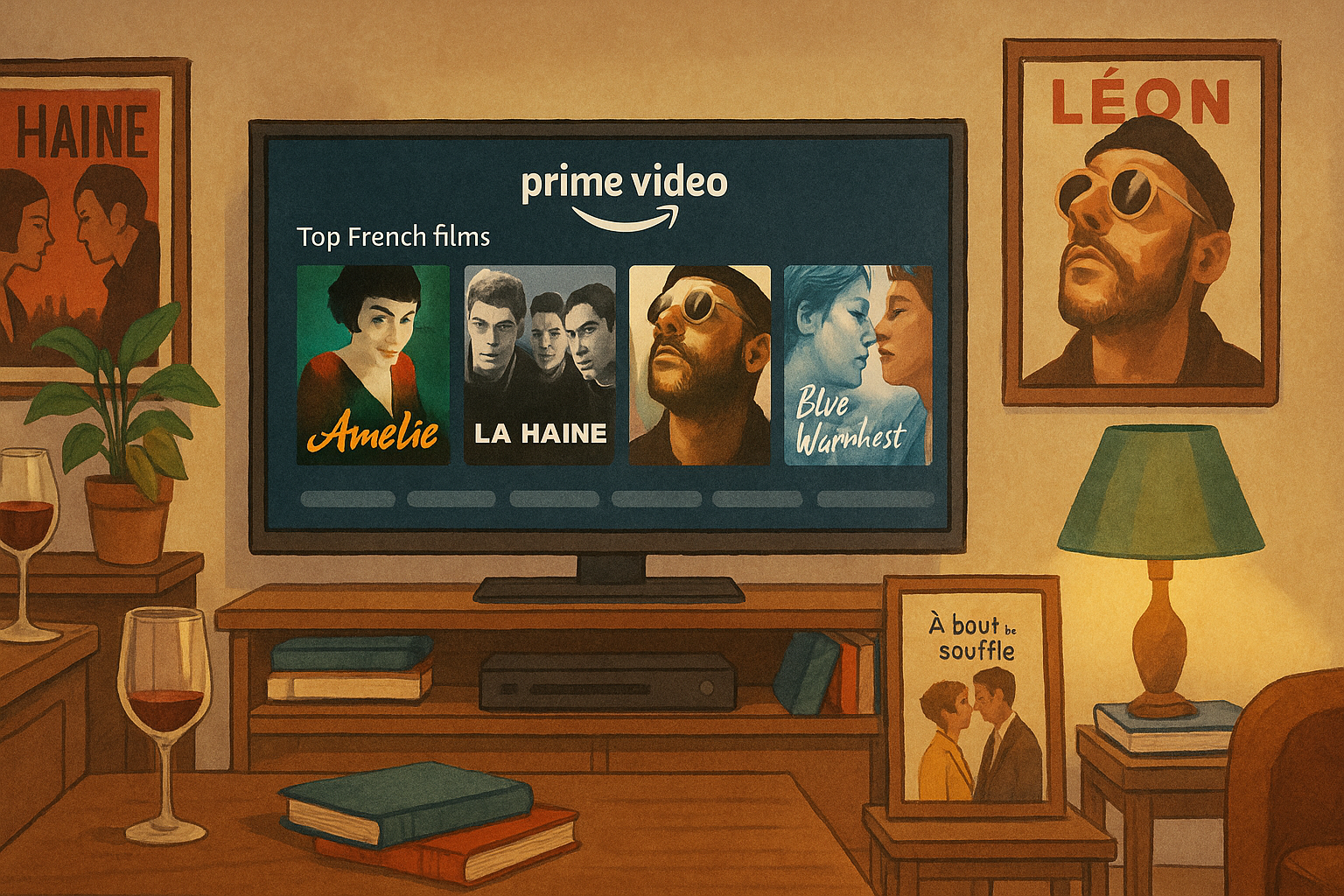French movies on Amazon Prime Video US — best films to learn French (A1–B2)
Amazon Prime Video offers an extensive collection of French films perfect for language learners, from beginner-friendly animations to complex dramas for advanced students. This comprehensive guide identifies the best French movies available on Prime Video US, organized by difficulty level, with proven strategies for using cinema to accelerate your French acquisition and cultural understanding.

Why French films accelerate language learning
Watching French cinema provides immersive exposure that textbooks cannot replicate. Films deliver authentic pronunciation, natural conversation pace, cultural context, body language cues, and emotional expression that reveal how French functions as a living language rather than academic abstraction. Research in second language acquisition consistently demonstrates that comprehensible input—content slightly above your current level—accelerates vocabulary retention, improves listening comprehension, and builds intuitive grammar understanding more effectively than isolated study.
French cinema specifically offers unique advantages for English speakers. France produces approximately three hundred films annually across all genres, providing diverse content matching any interest or proficiency level. The French film tradition emphasizes dialogue-driven storytelling over action spectacle, creating language-rich narratives perfect for learners. Subtitles in both English and French allow strategic progression from relying on translation to direct comprehension as skills develop.
Amazon Prime Video’s French collection updates regularly, combining classic French cinema with contemporary releases. While the selection changes periodically based on licensing agreements, Prime consistently maintains strong French film availability making it valuable for learners already subscribing for other content. This guide focuses on perennially available titles and identifies characteristics of effective learning films regardless of specific current availability.
The strategic subtitle progression method
Four-stage subtitle strategy for maximum learning
Stage 1 (A1-A2 beginners): French audio + English subtitles. Understand the story while hearing authentic French pronunciation and intonation. Focus on recognizing familiar words when you hear them.
Stage 2 (A2-B1 intermediate): French audio + French subtitles. Read along while listening, connecting written and spoken forms. Pause to look up unknown words. This stage builds vocabulary most rapidly.
Stage 3 (B1-B2 advancing): French audio, no subtitles, but prepared. Watch first with French subtitles to understand plot, then rewatch without subtitles testing comprehension. Fill gaps with context clues.
Stage 4 (B2+ advanced): French audio, no subtitles, cold viewing. Challenge yourself with new content without preparation, accepting you’ll miss some details while capturing main ideas.
This progression mirrors natural language acquisition better than jumping directly to French-only viewing. Each stage builds specific skills—ear training, reading speed, vocabulary recognition, contextual inference—that compound into comprehensive understanding. Most learners advance through these stages over months of consistent practice rather than days, requiring patience with the gradual process.
The multiple viewing technique
Watching the same film multiple times with different subtitle configurations provides more learning value than watching many films once. First viewing with English subtitles establishes plot comprehension. Second viewing with French subtitles builds vocabulary and reading-listening connection. Third viewing without subtitles tests listening comprehension. This repetition transforms passive entertainment into active learning while maintaining enjoyment through already-understood story.
Best French films for beginners (A1-A2)
The Intouchables (Intouchables, 2011)
Why it works for beginners: Clear dialogue, contemporary vocabulary, humor transcending language barriers, repetitive phrases reinforcing common expressions, universal themes of friendship requiring minimal cultural background.
Learning focus: Everyday conversation, informal French, basic question formation, present tense dominance
Cultural value: Modern French society, class dynamics, disability perspectives, multicultural Paris
Key phrase to learn:
🇫🇷 FR — Ça va ? /sa va/
🇺🇸 EN — How’s it going? / You okay?
(Used repeatedly throughout the film in various contexts)
Amélie (Le Fabuleux Destin d’Amélie Poulain, 2001)
Why it works for beginners: Slower-paced dialogue, extensive narration providing clear pronunciation, visual storytelling reducing language dependence, whimsical tone maintaining engagement despite comprehension gaps, iconic status motivating completion.
Learning focus: Descriptive vocabulary, adjectives, Paris neighborhood vocabulary, past tense narration
Cultural value: Parisian life, Montmartre neighborhood, French romanticism, café culture
The Little Prince (Le Petit Prince, 2015)
Why it works for beginners: Animated format with clear enunciation, simple sentence structures, repetitive dialogue patterns, universal story familiar to many English speakers, gentle pacing allowing processing time.
Learning focus: Basic grammar structures, common verbs, simple past tense, philosophical vocabulary in accessible context
Cultural value: Classic French literature, French approach to childhood and philosophy
💡 Animation advantage: French animated films (Le Petit Prince, Ernest & Celestine, The Triplets of Belleville) provide ideal beginner content through simplified vocabulary, clear articulation, and visual context clues supporting comprehension.
Intermediate French films (B1-B2)
Portrait of a Lady on Fire (Portrait de la jeune fille en feu, 2019)
Why it works for intermediates: Deliberate pacing allowing comprehension time, elevated but clear French, period setting introducing historical vocabulary, artistic cinematography providing visual context, dialogue-driven narrative.
Learning focus: Formal register, artistic vocabulary, descriptive language, conditional and subjunctive mood in context
Cultural value: 18th-century France, art history, women’s history, French cinema aesthetics
The Class (Entre les murs, 2008)
Why it works for intermediates: Contemporary French across social classes, authentic classroom French, debates and discussions modeling argumentation, suburban Paris vocabulary, realistic teenager speech patterns.
Learning focus: Educational vocabulary, debate structures, informal vs formal French, subjunctive in opinion expressions
Cultural value: French education system, multiculturalism, contemporary social issues
La Haine (Hate, 1995)
Why it works for intermediates: Authentic banlieue French, slang exposure, rapid realistic dialogue, cultural commentary requiring contextual understanding, powerful performances maintaining engagement.
Learning focus: Informal French, verlan (French slang reversal), street vocabulary, fast-paced conversation comprehension
Cultural value: Suburban social issues, police relations, French rap culture, immigration perspectives
Warning: Contains strong language and mature themes; challenges even intermediate learners with rapid slang-heavy dialogue
Tell No One (Ne le dis à personne, 2006)
Why it works for intermediates: Thriller genre maintaining engagement despite comprehension challenges, clear plot structure supporting understanding, contemporary French, moderate pacing, suspense motivating continued viewing.
Learning focus: Narrative past tense, suspense vocabulary, question formation in investigation contexts, complex sentence structures
Cultural value: French thriller conventions, police procedures, contemporary French society
Learning by genre — finding your interest
Comedy — learn through laughter
French comedies provide accessible entry points through universal humor, physical comedy reducing language dependence, and repetitive joke structures reinforcing vocabulary. “The Intouchables,” “Heartbreaker” (L’Arnacoeur), and “The Brice Man” showcase different comedy styles while teaching conversational French through naturally funny contexts that make language memorable.
Romance — emotion aids comprehension
Romantic films emphasize dialogue and emotion over action, creating language-rich content. Body language and romantic tension provide context clues supporting comprehension. “Amélie,” “Mood Indigo” (L’Écume des jours), and “Blue Is the Warmest Color” offer varying complexity levels while teaching the vocabulary of emotion, relationships, and intimacy essential for natural French conversation.
Drama — depth builds vocabulary
French dramatic cinema explores complex themes through extensive dialogue, building sophisticated vocabulary around psychology, philosophy, and social issues. “The Class,” “Rust and Bone” (De rouille et d’os), and “Incendies” challenge intermediate learners while rewarding effort with profound cultural insights and nuanced language exposure.
Historical — cultural context and period vocabulary
Period films provide historical context while teaching formal French and historical vocabulary. “Ridicule,” “Cyrano de Bergerac,” and “Marie Antoinette” (Sofia Coppola version with significant French) offer glimpses into French history while demonstrating how language evolved and formal registers function.
Active viewing techniques that maximize learning
The vocabulary notebook method
Keep a dedicated notebook while watching. Pause when encountering unknown words or interesting phrases. Write the French phrase, timestamp, context, and English meaning. After the film, create flashcards from your most useful discoveries. This active engagement transforms passive viewing into vocabulary acquisition session.
Example notebook entry:
🇫🇷 FR — Je m’en fiche. /ʒə mɑ̃ fiʃ/ [timestamp: 32:15]
Context: Character expressing indifference to criticism
🇺🇸 EN — I don’t care. / I don’t give a damn.
Note: Informal expression, use with friends not professional contexts
Shadowing practice
Select a short scene (two to three minutes) and replay it multiple times. First, watch with subtitles understanding content. Second, watch without subtitles focusing only on listening. Third, pause after each sentence and repeat it aloud, mimicking pronunciation, intonation, and rhythm. This shadowing technique dramatically improves pronunciation and speaking fluency by training your mouth to produce authentic French sounds.
Scene recreation
After watching a film with French subtitles, select a memorable dialogue scene. Read the subtitles aloud playing both characters’ parts. Record yourself and compare to the original. This exercise builds reading fluency, pronunciation accuracy, and conversational rhythm while providing measurable progress benchmarks as your recordings improve over time.
Cultural research enhancement
After watching a film, research its cultural context—historical period, social issues addressed, director’s background, French critical reception. This research deepens cultural understanding while providing French reading practice if you use French-language sources. Understanding cultural context makes subsequent French content more comprehensible by building background knowledge.
💡 Viewing frequency tip: Watch one French film weekly rather than binging multiple films in one sitting. Spaced exposure allows new vocabulary to consolidate in memory before encountering additional new words, preventing cognitive overload while maintaining consistent contact with French.
Common mistakes that limit learning effectiveness
Mistake 1: Choosing films far above your level
Beginning learners often select acclaimed art films with complex dialogue, abstract themes, and rapid speech—then become frustrated by incomprehension. Start with films explicitly designed for learners or known for clear dialogue before progressing to challenging content. Choosing appropriate difficulty maintains motivation while building skills systematically.
Mistake 2: Never rewatching films
Watching one hundred different films once provides less learning value than watching ten films ten times each. Repeated viewing allows noticing previously missed details, recognizing vocabulary in different contexts, and tracking your improving comprehension. The familiarity also makes viewing more enjoyable as you appreciate new layers rather than struggling constantly with unfamiliarity.
Mistake 3: Passive watching without engagement
Treating French films as background entertainment while checking your phone wastes learning potential. Active viewing—taking notes, pausing for unknown words, rewinding confusing sections, practicing pronunciation—requires focused attention but produces dramatically better results than passive consumption.
Mistake 4: Skipping English subtitles entirely too early
Some learners believe removing English subtitles immediately accelerates learning through immersion. However, watching content you don’t understand provides minimal learning benefit—you cannot acquire language from incomprehensible input. Use English subtitles strategically during early stages, gradually transitioning to French subtitles, then no subtitles as comprehension develops.
⚠️ Availability warning: Prime Video’s French film selection changes regularly based on licensing agreements. Films mentioned may temporarily become unavailable. Check current availability before planning viewing schedule, and explore newly added French content as Prime updates its catalog monthly.
Complementing films with structured learning
While French films provide excellent supplementary exposure, they cannot replace systematic grammar study, structured lessons with feedback, and active production practice. Films build listening comprehension and passive vocabulary but develop speaking and writing skills minimally without dedicated practice. Optimal French learning combines film viewing with comprehensive curriculum covering all competencies.
Consider films as the enjoyable thirty percent of your study routine rather than the entirety. Allocate remaining time to grammar study, conversation practice, reading, and writing exercises. This balanced approach leverages films’ motivational and cultural benefits while ensuring systematic skill development across all areas.
Connecting films to active practice
After watching a French film, discuss it in French with tutors or language exchange partners. Describe the plot, share opinions about characters, debate themes, and compare to similar English-language films. This active production practice transforms passive film viewing into speaking and critical thinking opportunities, solidifying vocabulary and structures encountered during viewing.
Beyond Prime Video — expanding your French film access
While this guide focuses on Amazon Prime Video, serious French learners benefit from accessing multiple streaming platforms. Netflix offers extensive French series complementing Prime’s film selection. The Criterion Channel provides classic French cinema with educational supplements. Kanopy (free with library cards in many US cities) offers curated French film collections with academic context.
French streaming platforms like TV5MONDEplus (free), France.tv (geo-blocked but accessible with VPN), and Arte.tv provide authentic French content with French subtitles designed for native speakers. These platforms offer more current French programming than US services, providing windows into contemporary French culture and language use unavailable through translated content.
Study glossary — film and cinema vocabulary
| FR | IPA | EN |
|---|---|---|
| Un film | /œ̃ film/ | A movie / film |
| Les sous-titres | /le sutitʁ/ | Subtitles |
| Le doublage | /lə dublaʒ/ | Dubbing |
| Version originale (VO) | /vɛʁsjɔ̃ ɔʁiʒinal/ | Original version |
| Un réalisateur | /œ̃ ʁealizatœʁ/ | Director |
| Un acteur / Une actrice | /œ̃n‿aktœʁ / yn aktʁis/ | Actor / Actress |
| Le scénario | /lə senaʁjo/ | Screenplay / script |
| Une scène | /yn sɛn/ | A scene |
| Le cinéma français | /lə sinema fʁɑ̃sɛ/ | French cinema |
| Un film d’animation | /œ̃ film danimasjɔ̃/ | Animated film |
| Un long métrage | /œ̃ lɔ̃ metʁaʒ/ | Feature film |
| La bande annonce | /la bɑ̃d anɔ̃s/ | Trailer |
Authoritative references
- Amazon Prime Video — official streaming platform.
- UniFrance — comprehensive French film database and resources.
Learn French with Roger, Native French Tutor
Expert instruction with proven teaching methods. Personalized lessons tailored to your goals from A0 to C1.
Weekly Lessons with Roger
Learn with Roger, a native French tutor. Structured curriculum from beginner to advanced.
- Native French speaker from France
- All levels (A0-C1) supported
- Personalized curriculum
- Proven teaching methodology
Trial Lesson with Roger
Experience Roger’s teaching method with a 25-minute trial session. Perfect to get started.
- 25 minutes with Roger
- Level assessment included
- Personalized learning roadmap
- No commitment required
A1 Foundations Guide
Complete beginner’s guide created by Roger. Structured lessons with native pronunciation.
- Step-by-step A1 curriculum
- Audio by native French speaker
- Practice exercises included
- Learn at your own pace
Continue Learning
Check out these related articles

Best online dictionaries for French to English translation — beyond WordReference (A1–C1)
Discover the best online French-English dictionaries beyond WordReference, including specialized tools for context, pronunciation, technical vocabulary, and professional translation that…

Exploring Montmartre culture (A1–B1) — art, cafés, viewpoints
Learn A1–B1 French for Montmartre: polite greetings, café ordering, directions, art talk, and viewpoint tips—bilingual lines with IPA and a…

Can you learn French in 3 months? — honest answer for English speakers (A1–B1)
Discover the honest truth about learning French in 3 months, what results are realistically achievable, which methods work fastest, and…
👋 Join Our Community
Follow us for daily tips, pronunciation tricks, and free resources
👍 Follow on Facebook